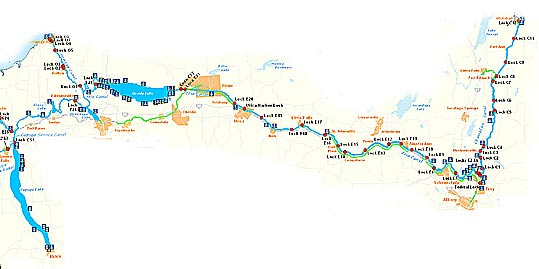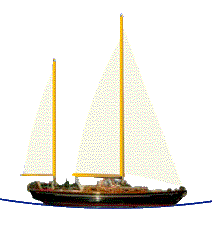



Ships Log Erie Canal: Seneca Falls to Little Falls September 14-17, 2005
After leaving Seneca Falls, we traveled back through the Montezuma National Wildlife Refuge, which consists of thousands of acres of marshland. It is mostly wetland areas interspersed with hummocks. Both cattails and bamboo stands thrive here, neither dominating. Birdlife is extensive with many heron, osprey and we saw the largest bald eagle we have ever observed. These wetlands do a wonderful job of cleaning the waters of the canal.
At this point, the canal shifts from a manmade structure bordered by towpaths to a route following natural waterways. There is much to say for both of these very different sections of the canal. The western section roughly follows the path of the original 1817 canal, which was updated and enlarged twice. The villages that line this portion of the canal were built after and because of the canal. There is little industry in this area and farming predominates. The eastern portion of the canal follows natural waterways and passes through villages and cities that existed as much as 100 years before the canal. There is much more industry in these towns. Early on, there were woolen mills and other small factories. Later, they were replaced by refineries and heavier industry. However, the stretches between towns are much more beautiful and natural and filled with healing wetlands.
The towns are full of history reaching centuries into the past. The topography is much more hilly and varied. Groundbreaking for the Erie Canal was in Rome, NY. Seven miles north of Lock 21 near Rome, is the Erie Canal Village, which is located on the original canal. Here, community life as it was on the canal is recreated. When the canal was completed in 1825, Governor De Witt Clinton traveled in a procession of canal boats from Buffalo to Albany and then all of the way to New York City. He carried a barrel of Lake Erie water and poured it into the Atlantic. This "Wedding of the Waters" was a masterstroke of PR, and captured the imagination of a nation.
The Oswego River connects the canal to Lake Ontario and is used by Canadians from Toronto to make their passage south. At Brewerton, we first saw the Taff-O-Dyl and we traveled in company with Taff and Dilys Olden for a portion of the canal.
We crossed 30-mile long Oneida Lake in the early morning rain. The lake is shallow much like Lake St. Clair and it is said that waves build quite high by the afternoon. We stopped for the night below Lock 20 and were given a tour of the beautifully maintained mechanics of the lock. The next day, we traveled to Little Falls. This town of 5000 has a charming mix of architecture from Victorian and Federalist and other styles. We met Harbormaster extraordinaire Tom Ryan and Kim Kelly and their famous Labrador retriever, Burke, who gave us an autographed copy of his book, "Burke The Erie Canal Boat Dog". We celebrated Mike's birthday with a wonderful dinner at the Canal Inn one night and then at Beardsley Castle on the 17th. The Castle is a notorious haunt of ghosts, although we did not see any ghosts while there.
